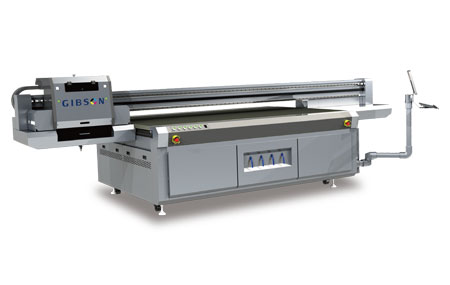UV printing technology glass printing trend
Website Editor:GIBSON │ release time:2019-11-25
The development of UV printing technology has opened up new opportunities for printers to try to print on different types of substrate materials.In the past, imaging on glass was mainly achieved through painting, etching and screen printing;Now, it can be done with UV inkjet printer technology.
The trend in glass printing is to get a high-end, high-quality color look.In addition, although one of the great USES of glass printing is for retail goods, its applications in architecture, engineering and interior design are also increasingly widespread.
Creativity in new substrate materials
Through the glass printing technology, artists can have a better performance.
Artists could display and sell paintings on tables, coffee tables, shower doors, glass kiosks, glass plates and other objects, combining them with artistic expression, and with the development of UV printing, they found new "canvases."
At present, another application is to print on the glass unique building signs that can be used in the interior of offices and reception areas.
Printing process
Painters and interior designers have found that printing glass on the reverse side is a very effective way to remove the need for adhesives.Printing on the back, or "second surface printing," allows the end product to be protected by the glass itself.
No coating is required
Uncoated glass, also can be successfully UV printing on glass.
Printing on glass with a low curing amount of light, and then curing the printing with a non-printing channel, "double printing" glass printing, or glass etching is used in place of increased viscosity or liquid coating, are methods of protecting glass.
Use glass as a canvas
Photographers, artists, printers and print makers have developed SuperSauce solutions, which contain about 91% isopropanol, to transfer paint-jet images onto glass.
UV - LED technology
The success of printing on glass depends on excellent adhesion and bonding ability.When printing with uv-led, three techniques can be used to improve adhesion.
This method is priming.
This technique requires priming the entire surface of the glass, using a non-fuzz cloth, which gives the surface a dull, dull appearance.
The second is a printing primer spray using MimakiPR-100 printer.The pr-100 can print the primer where it is needed without any other wiping or polishing process.
The third technique is plasma processing.First, it removes various surface impurities, such as dust or residues that may be left behind by solvent cleaners.At the same time, it produces a surface that is more conducive to combining with the ink.
Other tips and tricks
There are several key steps to follow to extend service life.
First, it is recommended to wear cotton gloves when printing.In addition, because of the manufacturing process, glass has a transparent side and a "foggy" side, and it must be printed on the transparent side.
The difference between other UV printing processes and specialized glass printing processes is the baking process after printing.This baking process binds glass, primer and ink together and the product lasts.
- Color bar test boject banding2021-7月-08
- How to solve the problem of UV lamp of UV flatbed printer?2021-6月-20
- Troubleshoot the problem of UV printer not producing ink2021-6月-18
- What should we pay attention to when UV packaging printing encounters plastic2021-6月-15
- Those materials that need to be coated before UV printing2021-6月-13
- The key to the use of UV flatbed printers to control costs2021-6月-10
- What is the difference between uv light curing machine and uv flatbed printer?2021-6月-08










